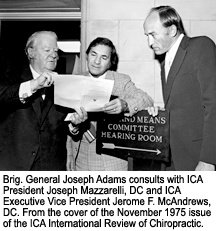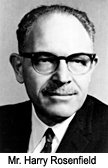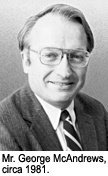Editor's Note: Part one of this article appeared in the Sept. 10 issue
 Perhaps not surprisingly, some DCs and their advisors were reluc-tant to accept the challenge Dr.
Perhaps not surprisingly, some DCs and their advisors were reluc-tant to accept the challenge Dr.
 The ICA's relatively rapid en-dorsement of the Wilk case was not matched at the headquarters of the American Chiropractic Association (ACA). Harry Rosenfield, chief legal counsel for the national membership society, believed that another attack upon the medical monopoly through the courts was not wise. The England case had paraded all the worst in the chiropractic profession past the jury (and the public), as exemplified by the contents of one of the books the AMA had surreptitiously supported: Ralph Lee Smith's At Your Own Risk: The Case Against Chiropractic.1
The ICA's relatively rapid en-dorsement of the Wilk case was not matched at the headquarters of the American Chiropractic Association (ACA). Harry Rosenfield, chief legal counsel for the national membership society, believed that another attack upon the medical monopoly through the courts was not wise. The England case had paraded all the worst in the chiropractic profession past the jury (and the public), as exemplified by the contents of one of the books the AMA had surreptitiously supported: Ralph Lee Smith's At Your Own Risk: The Case Against Chiropractic.1
Rosenfield anticipated (as it turned out, correctly) that the same treatment was likely if the Wilk case were pursued. His resistance to Dr. Wilk's strategy delayed the ACA's endorsement and severely inhibited the success of fundraising for the case.2
 It was not that the ACA's attorney did not understand the important differences between the England case and the Wilk case. The former was a quest to establish licensure through judicial mandate. The latter was an effort to use the Sherman Anti-Trust Act in order to put an end to the illegal conspiracy and economic boycott orchestrated by the AMA's Committee on Quackery. The focus of the plaintiff's case in Wilk, et al. v. AMA, et al. was not the merits of chiropractic, but rather the AMA's campaign to "contain and eliminate" the chiropractic profession: a campaign that illegally limited competition in the health care marketplace. Rosenfield appreciated the distinction. What he dreaded was a rehash of the public humiliation the profession had undergone in New Orleans in 1965 - something that mattered a few years later when the U.S. Congress was considering whether to include DCs in the Medicare program.3 However, bitter sentiments against Mr. Rosenfield linger.4-5
It was not that the ACA's attorney did not understand the important differences between the England case and the Wilk case. The former was a quest to establish licensure through judicial mandate. The latter was an effort to use the Sherman Anti-Trust Act in order to put an end to the illegal conspiracy and economic boycott orchestrated by the AMA's Committee on Quackery. The focus of the plaintiff's case in Wilk, et al. v. AMA, et al. was not the merits of chiropractic, but rather the AMA's campaign to "contain and eliminate" the chiropractic profession: a campaign that illegally limited competition in the health care marketplace. Rosenfield appreciated the distinction. What he dreaded was a rehash of the public humiliation the profession had undergone in New Orleans in 1965 - something that mattered a few years later when the U.S. Congress was considering whether to include DCs in the Medicare program.3 However, bitter sentiments against Mr. Rosenfield linger.4-5
The first trial in the Wilk case may be seen as something of an ironic vindication for the ACA's attorney. By the time the trial ended (1981), the ACA had long since become a strong supporter of the antitrust lawsuit. The verdict was rendered by a panel of citizens who listened to the economic arguments presented by Mr. George McAndrews, chief attorney for Dr. Wilk and associates. The jury also listened to the defendants' recitation of the same sorts of fantastic and dubious clinical claims made by technique gurus and practice consultants, and the same greedy and unethical strategies recommended by those who instructed DCs on how to build their practices. In a post-trial interview of a few of the jurors, Mr. McAndrews learned that notwithstanding the unjustified police powers exercised by the AMA, et al., some of the jurors believed that several of the DCs brought to their attention belonged in jail. Although the trial prompted the AMA to eliminate its "ethical" ban against professional collaboration between its members and "unscientific" practitioners, once again the DCs had defeated themselves.
In the second trial, the plaintiffs waived punitive damages in exchange for a trial by magistrate. This strategy required Judge Getzendanner to serve as the sole arbiter between the DCs and the forces of political medicine. After reviewing all the evidence provided by the plaintiffs and defendants, she had to decide whether or not commerce had been illegally restrained, but she did not have to consider the financial magnitude of the economic loss to the defendants. Once again, the evidence included the sorry tales of DCs' sins against reason and patient welfare. Once again, barbaric stories were recounted about the neglect of the medical needs of patients for no other reason than the "taint" of quackery (e.g., a patient referred by a DC). The judge found in favor of the DCs in 1987, and her ruling was sustained by higher courts in the next few years. She mandated that the AMA publish her ruling in their premier periodical, JAMA, so the seriousness and extent of the medical society's misbehavior would come to the attention of all MDs throughout the land.
Fifty years ago, Dr. Jerry England and associates went to court to present the grievances that chiropractors held against political medicine in Louisiana. Almost 20 years later, Dr. Chester Wilk and associates commenced a similar effort in the federal court in Chicago. These two initiatives consumed great time and energy on the part of plaintiff DCs and their supporters throughout the profession. These cases also brought shame upon the profession when the greedy and unethical practices of a number of DCs were held up to the scrutiny of judges and juries. Defeat came to England, et al., in part because of a faulty strategy in seeking licensure through the courts rather than the legislature. Victory eventually came to Wilk, et al., in part because of the grievousness of political medicine's abuse of the public trust and in part because the dedicated and brilliant work of DCs' legal counsel outweighed the shameful behavior of some in the chiropractic profession.
This writer feels that the lessons to be learned from studying the England case and the Wilk case are pretty clear. Unfortunately, some of these lessons do not yet concern a vocal majority of DCs or MDs. Indeed, public discussion of these issues still is considered politically incorrect in many corners of the community of health care providers. Notwithstanding any remedies applied by the courts, the losers - in the Wilk case, the England case and in much of the political feuding between DCs and MDs - are the patients. Who will stand up for patients and require that allopathic and chiropractic doctors work together in the public's best interest? Perhaps another legal battle will be needed; it will not be pretty.
References
- Smith RL. At Your Own Risk: The Case Against Chiropractic. New York: Pocket Books, 1969.
- Holmberg W. Notes on the Wilk case, unpublished (June 2007).
- Wardwell WI. Chiropractic: History and Evolution of a New Profession. St. Louis: Mosby, 1992.
- Sportelli L. E-mail to J.C. Keating, June 10, 2007.
- Wilk CA. Medicine, Monopolies and Malice. Chicago: the author, 1996.
Click here for previous articles by Joseph Keating Jr., PhD.





